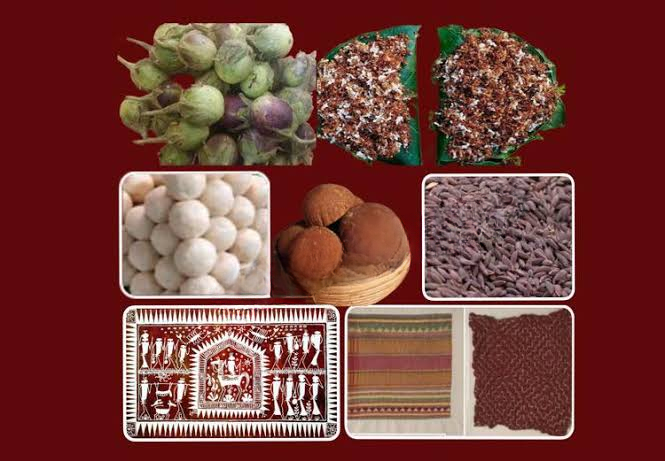From red ant chutney to black rice, the 7 Odisha products that have bagged GI tags (Indian Express)

- 08 Jan 2024
Why is it in the News
Seven products from Odisha, ranging from the Similipal Kai chutney made with red weaver ants to the embroidered Kapdaganda shawl, have bagged the coveted Geographical Indication (GI) tag in recognition of their exclusivity to the state.
What is Geographical Indication (GI) Tag?
- Geographical Indications of goods refer to the place of origin of a product.
- Such tags are accorded as they convey an assurance of quality and distinctiveness, attributable to the fact of its origin in a specific geographical locality, region or country.
- In India, the Department for Promotion of Industry and Internal Trade, Ministry of Commerce and Industry, awards GIs.
- A GI registration is given to an area, not a trader, but once a product gets the registration, traders dealing in the product can apply to sell it with the GI logo.
- Authorised traders are each assigned a unique GI number.
- If any unauthorised trader tries selling the product under that name, they can be prosecuted under The Geographical Indications of Goods (Registration and Protection) Act, 1999.
- A marker of authentic products, the GI tags also help protect the interests of the local growers and artisans by preventing duplicity of the products and sale from unauthorised traders.
- Consumers, through the tags, can know which goods are certified.
The Seven Products and Their Distinctiveness:
- Kapdaganda shawl: Woven and embroidered by the women of the Dongria Kondh tribe, a particularly vulnerable tribal group (PVTG) in the Niyamgiri hills in Odisha’s Rayagada and Kalahandi districts, the shawl reflects the rich tribal heritage of the Dongria Kondhs.
- It is embroidered on an off-white coarse cloth with red, yellow and green coloured threads, with each colour holding significance.
- Green symbolises the mountains and hills, and yellow stands for peace and happiness.
- Red stands as the symbol of blood.
- The motifs in the shawls are mostly lines and triangles, believed to be a reflection of the importance of mountains for the community.
- The shawl is worn by both men and women and the Dongrias gift it to their family members as a token of love and affection.
- It is embroidered on an off-white coarse cloth with red, yellow and green coloured threads, with each colour holding significance.
- Lanjia Saura Painting: The painting is also known as Idital. The artworks are famous for their beauty, aesthetics, ritualistic association and iconography.
- The art form belongs to the Lanjia Saura community, a PVTG largely residing in the Rayagada district.
- These paintings are in the form of exterior murals painted on the mud walls of homes.
- White paintings figure over a crimson-maroon background.
- It is believed that the Lanjia Sauras paint their walls with Idital artworks to show gratitude to their deities and forefathers, and also for the well-being of their community.
- Reflecting the love and affection of the primitive tribes for nature, they feature subjects like tribal humans, trees, animals, birds, the Sun and the Moon.
- Koraput Kala Jeera Rice: The black-coloured rice variety, also known as the ‘Prince of Rice’, is famous for its aroma, taste, texture and nutritional value.
- Tribal farmers of the Koraput region have preserved the rice variety for around 1,000 years.
- As the rice grains resemble cumin seeds, it is also called Kala Jeera. Consumption of the rice variety helps in increasing haemoglobin levels and improves metabolism in the body.
- The farmers and producers of Koraput Kala Jeera rice have followed the traditional knowledge and practices in cultivation.
- Similipal Kai chutney: The chutney made with red weaver ants is a traditional delicacy of the tribals in Odisha’s Mayurbhanj district.
- The ants are found in the forests of Mayurbhanj, including in the Similipal forests – Asia’s second-largest biosphere.
- Rich in medicinal and nutritional value, the chutney is believed to be a good source of nutrients like protein, calcium, zinc, vitamin B-12, iron, magnesium, potassium, etc.
- The tribals prepare the Kai chutney by grinding the ants manually on a Sil Batta or the grinding stone.
- Mayurbhanj’s tribals also earn their livelihood by selling the red ants and the chutney made from the ants.
- They believe that its consumption helps boost immunity and prevents diseases.
- Nayagarh Kanteimundi Brinjal: Nayagarh Kanteimundi Brinjal is known for its prickly thorns on the stems and the whole plant.
- The green and round fruits contain more seeds as compared to other genotypes.
- It is famous for its unique taste and relatively short quick cooking time. The plants are resistant to major insects and can be grown with minimal pesticide.
- It is being widely cultivated in Nayagarh district of the state.
- Odisha Khajuri Guda: Odisha’s “Khajuri Guda” or jaggery is a natural sweetener extracted from date palm trees and has its origin in the Gajapati district.
- Traditionally, the jaggery is prepared in a trapezoidal form called ‘Patali Gur’ and is organic by nature.
- It is dark brown and has a unique taste.
- Dhenkanal Magji: Dhenkanal Magji is a type of sweet made from cheese from buffalo milk, with distinct characteristics in terms of appearance, taste, flavour, shape, and size.
- It also has unique nutritional values that distinguish it from other cheese-based sweets.
- The sweet is prepared by draining moisture from the cheese and then frying it, finally forming balls from the mixture.
